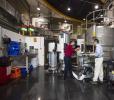
Showing 201 - 220 of 296 results

Biological small angle X-ray scattering beamline (BioSAXS)
The Biological Small Angle X-ray Scattering beamline will be optimised for measuring small angle scattering of surfactants, nanoparticles, polymers, lipids, proteins and other biological macromolecules in solution. BioSAXS combines combine a state-of-the-art high-flux small angle scattering beamline with specialised in-line protein purification and preparation techniques for high-throughput protein analysis.
Shorebirds Competition 2020
A lesson in Science and Sustainability.

Role at ANSTO
Advancing particle therapy
Meeting of minds about potential next-generation cancer treatment for Australians
Investigating the impact of radiation and radioactive contamination on forensic trace evidence

User Meeting 2020 Invited Speakers
The User Advisory Committee (UAC) are pleased to present this year's invited speakers.

Delivery schedule
Latest information on the scheduled supply of our nuclear medicine production.

Role at ANSTO
Sharing environmental expertise
Australia assists in the collection of marine sediments to support contaminant quality control measures by IAEA.
Fusion research in Australia
Australia part of global renaissance in fusion power research symbolised by ITER experiment
MOU formalises cooperation with Vietnamese nuclear agencies
Discussions were held on possible areas on cooperation including research reactor operation and utilisation, environmental monitoring of mining tails, and food provenance.
Vice President of the German Parliament visits
Wolfgang Kubicki, MdB and a small delegation visited to see the Spatz neutron instrument donated by Helmholtz Zentrum Berlin (HZB) and discuss research.
Environmental conference highlights the role isotopes have in better supporting our precious ecosystems
Radiation Monitoring
ANSTO continually monitors environmental gamma radiation from a station located in Engadine NSW. ANSTO uses environmental radiation data to evaluate atmospheric dispersion from its site. This radiation is almost completely natural background radiation.
Critical minerals projects funded under Australian Research Centre Projects Program
ANSTO is contributing to key critical minerals projects funded by the Federal Government.
Small modular reactors can be built with Generation IV reactor designs
Small modular reactors can be built using Generation IV reactor technologies, that old the promise of considerably higher efficiency for decarbonised energy production and industrial heat co-generation.
ANSTO helps verify the origin of traditional Aboriginal products to benefit consumer confidence and Aboriginal enterprises
ANSTO fights cancer
Commitment to undertake health research.

Working at ANSTO
ANSTO offers a diverse range of career opportunities within science, engineering, corporate services and trade disciplines.